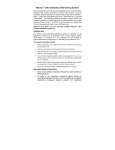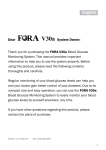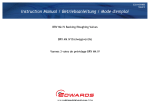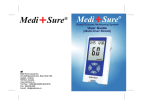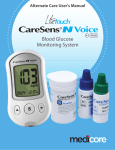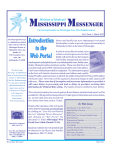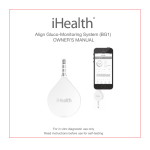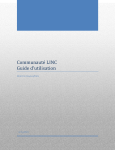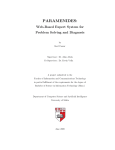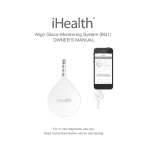Download performing a blood glucose test
Transcript
Thank you for purchasing the SD Gluco Navii™ Blood Glucose Monitoring System. This manual provides important information to help you to use the system properly. Before using this product, please read the following contents thoroughly and carefully. Please note that the following procedures are provided only as an example to help your facility establish its own policy and procedures. Your own policy may differ. Please consult with your director of nursing or administrator for further guidance. For Questions Regarding Gluco Navii™ CALL (949) 753 - 0001 or (888) 425 - 1149 CAUTION: Please carefully read the User’s Manual and all product instructions before using the Gluco Navii™ Blood Glucose Meter. TABLE OF CONTENTS Important Safety Precautions 3 Precautions & Limitations Interfering Substances 4 Before you begin 5 Intended Use 5 Test Principle 6 Alternative Site Testing 6 Meter Setup / Programming 8 Performing a Blood Glucose Test 15 Test Results 17 Using the Meter Memory to Review Results 18 Maintenance 20 Screen Messages and Troubleshooting 26 Warnings, Precautions and Limitations 28 System Specifications 29 Electromagnetic Compatibility 29 Performance Characteristics 29 Training Tools 32 2 IMPORTANT SAFETY PRECAUTIONS READ BEFORE USE Users need to adhere to Standard Precautions when handling or using this device. All parts of the glucose monitoring system should be considered potentially infectious and are capable of transmitting blood-borne pathogens between patients and healthcare professionals. For more information, refer to “Guideline for Isolation Precautions: Preventing Transmission of Infectious Agents in Healthcare Settings 2007”, http://www.cdc.gov/hicpac/2007ip/2007isolationprecautions.html. WARNING The GlucoNavii™ meter should be disinfected after use on each patient. The Gluco Navii™ Blood Glucose Monitoring System may only be used for testing multiple patients when Standard Precautions and the Manufacturer’s Disinfection Procedures are followed. WHEN USED FOR TESTING MULTIPLE PATIENTS THE METER MUST BE CLEANED/DISINFECTED AFTER USE ON EACH PATIENT. WARNING Only auto-disabling, single use lancing devices should be used with this device. DO NOT USE REUSABLE LANCING DEVICES WITH THE Gluco Navii™ PRODUCT. 1. Use this device ONLY for the intended use, described in this manual. 2. DO NOT use accessories which are not specified by the manufacturer. 3. DO NOT use the device if it is not working properly or if it is damaged. 4. DO NOT under any circumstances use the device on neonates or infants. 5. This device does NOT serve as a treatment or a cure for any symptom or disease. The data measured is for reference only. 6. Before using this device to test blood glucose, read all instructions thoroughly and practice performing a test. Carry out all the quality control checks as directed. 7. Keep the device and testing equipment away from young children. Small items such as the battery cover, batteries, test strips, lancets, vials and vial caps are choking hazards. 3 PRECAUTIONS & LIMITATIONS INTERFERING SUBSTANCES Interfering substances depend on the concentration. The interfering substances listed below may produce elevated glucose test results (at or above the concentration levels noted). Regulatory Requirements The Clinical Laboratory Improvement Amendments (CLIA) has classified tests of blood glucose as tests that are waived. For all entities that conduct one or more tests, including waived tests on materials derived from the human body for the purpose of providing information for the diagnosis, prevention or treatment of any disease or impairment of, or the assessment of the health of human beings, CLIA has stated that the entity conducting the tests shall meet certain Federal requirements. If any entity conducts tests for the aforementioned purposes, then the entity, under CLIA, is considered to be a laboratory and thus must register with the CLIA Program. KEEP THESE INSTRUCTIONS IN A SAFE PLACE 4 BEFORE YOU BEGIN Severe dehydration and excessive water loss may cause readings which are lower than actual values. If the patient is suffering from severe dehydration, consult a healthcare professional immediately. If the patient’s blood glucose results are lower or higher than usual, and they do not have any symptoms of illness, repeat the test. If the patient has symptoms or continues to get results which are higher or lower than usual, follow the treatment advice of the healthcare professional. Use only fresh whole blood samples to test patient’s blood glucose. Using other substances will lead to incorrect results.DO NOT use Gluco Navii™ to test serum, plasma or stored whole blood. If the patient has symptoms that are inconsistent with the blood glucose test results and you have followed all the instructions given in this owner’s manual, contact a healthcare professional. We do not recommend using this product on severely hypotensive individuals or patients in shock. Readings which are lower than actual values may occur for individuals experiencing a hyperglycaemic-hyperosmolar state, with or without ketosis. Please consult the healthcare professional before use. INTENDED USE SD GlucoNavii™ blood glucose monitoring system is indicated for monitoring glucose in fresh capillary whole blood samples drawn from the fingertip, palm, forearm or upper arm. SD GlucoNavii™ meter must be used with SD GlucoNavii™ blood glucose test strips and SD Control solutions. The SD control solutions Level M and Level H are for use with SD GlucoNavii™ test system as quality controls to verify the accuracy of blood glucose test results. Testing with Gluco Navii™ is done outside the body (in vitro diagnostic use). This system is indicated for home (over-the-counter, OTC) by persons with diabetes, or in clinical settings by healthcare professionals, as an aid to monitor the effectiveness of diabetes control. This system should not be used for the screening or diagnosis of diabetes or for testing newborns or infants. 5 THE PRINCIPAL SD GlucoNavii™ test strip is designed with an electrode that measures glucose levels. Glucose in the blood sample mixes with reagent on the test strip which causes a small electric current. The amount of current that is created depends on how much glucose is in the blood. SD GlucoNavii™ meter measures the current that is created and converts the measurement to the amount of glucose that is in the blood. The blood glucose result is displayed on the meter’s screen. By touching a drop of blood to the tip of the SD GlucoNavii™ test strip, the strip’s reaction chamber automatically draws the blood into the strip through capillary action. When the chamber is full, SD GlucoNavii™ meter starts to measure the blood glucose level. It is a simple and practical system for the daily monitoring of your blood glucose level. ALTERNATIVE SITE TESTING IMPORTANT: There are limitations with AST (Alternative Site Testing). The AST of the system can be used only during steady-state blood glucose conditions. Please consult the doctor before you perform AST on the patient. Measurements from AST should never be used to calibrate a continuous glucose monitoring systems (CGMs) or entered into insulin dose calculators for insulin dosing recommendations. 6 What is AST? Alternative site testing (AST) means that people use parts of the body other than fingertips to check their blood glucose levels. The GlucoNavii™ system allows you to test on the finger, palm and forearm. What’s the advantage of AST? Fingertips feel pain more readily because they are full of nerve endings (receptors). Other body sites, since nerve endings are less concentrated, patients generally will not feel as much pain compared to the fingertip. When to use AST? Food, medication, illness, stress and exercise can affect blood glucose levels. Capillary blood at fingertip reflects these changes faster than capillary blood at other sites. Therefore when testing blood glucose during or immediately after meal, physical exercise, or any other event, take blood sample from finger only. We strongly recommend that you perform AST ONLY at the following times: • With you healthcare providers permission. • In a pre-meal or fasting state (more than 2 hours since the last meal). • Two hours or more after taking insulin. • Two hours or more after exercise. Do NOT use AST if: • The healthcare provider has not approved this type of testing. • Your patient has frequent low blood glucose. • The AST results do not match the way the patient feels. • You are testing for hyperglycemia. • You are testing for hypoglycemia. • The patient’s routine glucose results are often fluctuating. 7 METER SET UP / PROGRAMMING STEP-1 : Setting the Audible Beep 1. With the meter turned on, press the ON/OFF button for 3 seconds, the display for setting the audible beep will appear (Note the small on the lower right area of screen). 2. Set the beep mode on or off by pressing the left arrow button to select either ON or OFF. If you select the ON feature, a ‘beep’ sound will be heard. If you select the OFF feature, no sound will be heard. 8 STEP-2 : Setting the Hypo Warning NOTE • You can set the GlucoNavii™ meter to let you know when the result indicates a possible low blood glucose (hypoglycemia) level. • You can also select what blood glucose level, the warning will be indicated, i.e 60, 70, 80 mg/dL. • If your results are lower than the selected level, the ‘hypo’ symbol will appear on the LCD screen with a ‘beep’ sound. • It is very important to manage your hypoglycemia. 1. After confirming the audible sound ON or OFF, the display for setting the hypo warning will appear. 2. Using the LEFT arrow key select OFF, 80, 70 or 60 mg/dL. (Note: each push of the left arrow key will scroll to the next choice). 3. After you have set the hypo warning mode OFF or the level to 60, 70 or 80 mg/dL by pressing the left button, press the ON/OFF button to confirm your choice. STEP-3 : Setting the date and time Setting the DATE - YEAR 1. After setting the hypo warning, the display for setting Date will appear. Set the correct year by pressing either the left or the right button (left = down, right=up until the correct year is displayed). Confirm the correct year by pressing the ON/OFF button in center of meter. 9 Setting the DATE - “DISPLAY FORMAT” 2. Next will appear the setting to choose the display for month and day format. The meter can display the month and day in either a Month/Day (m-d) format or a Day/Month (d-m) format. Set the preferred format on the display by pressing either the left or the right button. Confirm by pressing the ON/OFF button in center of meter. Setting the DATE - “MONTH” 3. Next set the correct month on the display by pressing either the left or the right button until the correct month appears and confirm by pressing the ON/OFF button. NOTE • In this mode the left button will move the number down, and the right button will move the number up. Setting the DATE - “DAY” 4. Next set the correct day on the display by pressing either the left or the right button until the correct date appears and confirm by pressing the ON/OFF button. NOTE • In this mode the left button will move the number down, and the right button will move the number up. 10 Setting the TIME - “FORMAT” 1. Next will appear the display for setting clock to the 12 or 24 Hour format. The meter can display the time in either the 12h format (i.e. AM/PM) or the 24h format. Set the preferred format on the display by pressing either the left or the right button and confirm your selection by pressing the ON/OFF button. Setting the TIME - “HOUR” 2. Next will appear the setting display to set HOUR. Set the correct hour on the display by pressing either the left or the right button and confirm your selection by pressing the ON/OFF button. NOTE • You must scroll through 12 hours to move from AM to PM. i.e. 10am, 11am, 12pm, 1pm, etc. Be sure the correct AM or PM selection is made before confirming hour and moving to next setup mode. 11 Setting the TIME - “MINUTE” 3. Next will appear the setting display for MINUTE. Set the correct minute on the display by pressing either the left or the right button. Confirm your selection by pressing the ON/OFF button. STEP-4 : Post-Meal Alarm You can use GlucoNavii’s post-meal alarm function to remind you to test your blood glucose after meal. 1. After day and time setting, the display for setting the post-meal alarm will appear. 2. Set the post-meal alarm mode to ‘2h’ or ‘OFF’ by pressing either the left or the right button and then confirm the selection by pressing the ON/OFF button. NOTE • If you select the post-meal alarm ‘2h’ feature and test with pre-meal mark, the ‘clock symbol’ will appear on result display and the ‘beep’ sound will be heard in 1 minute (or until shut off) 2 hours after the pre-meal test time. • If you perform the pre-meal test while the post-meal alarm setting is on, then the post-meal mark will appear automatically on your LCD when you test within following period: from 30min to 130min after your pre-meal test. • If you mark the new test result with a pre-meal mark, the old alarm setting will be ignored and only the new setting will sound in 2 hours. 12 STEP-5 : Setting the Test Reminder Alarm GlucoNavii™ includes an alarm function to remind you to test your blood glucose. Up to 4 reminder alarms may be set. 1. After Post-meal alarm setting the display for setting the first alarm will appear. 2. Set the first alarm ON or OFF by pressing either the left or the right button and then confirm your selection by pressing the ON/OFF button. NOTE • If you select the alarm “OFF” feature, set-up is complete. • If you select the alarm “ON” feature, you can set the next alarm. Up to four alarms per day may be set once “OFF” is selected, set up is complete. 13 3. If you select the alarm “ON” feature in first alarm mode, the clock will begin to blink. Set the correct hour and minute you want to be reminded to test for by pressing either the left or the right button. Confirm the selection by pressing the ON/OFF button. 4. Once you finish setting the first alarm, you can set three additional alarms. For each alarm, set the time as you did for the first alarm. Alarm 2 Alarm 3 Alarm 4 5. When you finish setting the last alarm setup is complete. NOTE • Once you select OFF for an alarm, no further alarms will be set. Setup is complete. i.e. if you select OFF for the first alarm, setup us complete. You will not be prompted to set additional alarms. 14 PERFORMING A BLOOD GLUCOSE TEST NOTE • Always wash hands with warm, soapy water. Rinse and dry them before testing. 1. Remove a new test strip from vial. Be sure to tightly close vial cap after removing test strip. 2. There are two ways to turn the meter on. The first method is to press the ON/OFF button. The second method is to insert the test strip into test strip slot and the meter turns on automatically. 3. When the blood drop symbol flashes next to the test strip symbol (Blood Stand-by Display), you are ready to perform a test. 4. Before you perform a test, you have the option to mark the test as either post-meal or pre-meal test by pressing the right button. Press the RIGHT button once for pre-meal or twice for post-meal. Pushing the RIGHT button again will turn OFF meal mark for that test. 15 NOTE • You do not have to mark a result. If you do not wish to track Pre-meal or Post-meal results simply perform your test after inserting the test strip and observing the “flashing blood drop” • If you perform the pre-meal test while the post-meal alarm setting is on, then the Post-meal mark will appear automatically on your LCD when you test within following period: from 30 minutes to 130 minutes after your pre-meal test. 5. Let your arm hang down at your side to allow blood to flow to your fingertips. Grasp your finger just below the joint closest to the fingertip. 6. Obtain a blood sample using a new lancet. 7. Hold your finger to the tip of the strip until the yellow window is completely filled with blood. Do not place the blood drop on top of the strip. 8. The blood will be drawn into the strip automatically. If audible sound is turned on, meter will beep to let you know the test has begun. 9. When blood is applied to the strip, the display counts down from 5 to 1 and your result appears on the display in 5 seconds. 10. The blood glucose result is displayed in mg/dL [Caution: If your GlucoNavii™ meter is desplaying results in mmol/L please stop usage and contact your supplier]. 11. When the test is done, pull out the used test strip and dispose. The meter shuts off automatically 5 seconds after you remove the test strip. NOTE • Dispose of the used test strip as per your facility guidelines. • Dispose of the used lancet according to facility guidelines. • Always use fresh capillary whole blood when performing tests DO NOT USE PLASMA, SERUM OR SAVED BLOOD. 16 Your Test Results 1. After 5 seconds from applying blood into strip, you will receive a result. Displayed results using the GlucoNavii™ range from 20mg/dL to 600mg/dL. DISPLAY FOR NORMAL RESULT 2. If your blood glucose is above 600 mg/dL, you will receive a “HI” indication on the display. If below 20 mg/dL, you will receive “Lo” indication on the display. In these cases, repeat the test with new test strip. If this message appears again, contact your healthcare professional immediately. DISPLAY FOR HI & LO RESULTS 3. If you set the pre-meal mark before your test, your result will be stored with a pre-meal mark. ( ). If you set the post-meal mark before you test, your result will be started with a post-meal mark ( ). Pre-Meal Post-Meal 17 USING THE METER MEMORY TO REVIEW RESULTS 1. Turn the meter on, press the LEFT button to review in sequence from the most recent test result to the last test result stored. 2. Turn the meter on, press the RIGHT button to review 7,14 and 30 day averages of test result stored. GlucoNavii™ allows you to view your average three ways. All results, pre-meal results and post-meal results. 18 3. If there are no stored test results, the following display will appear for 1 sec., and then the meter will display strip stand-by state automatically. • METER MEMORY. The GlucoNavii™ has the ability to store 400 results in its memory. Once the memory capacity has been reached, the oldest result will be deleted. NORMAL BLOOD GLUCOSE READINGS The normal fasting blood glucose range for an adult without diabetes is 74 - 106 mg/dL. Two hours after meals, the blood glucose range for an adult without diabetes is less than 140 mg/dL. • Your results may vary. Consult with your healthcare provider if you have any questions about your results or how you feel does not match your results. WHAT THIS MEANS FOR YOU Frequent blood glucose testing is the best means to track how well you are doing with your diabetes management. It helps you track the effects of medications, diet, exercise, and stress management. Blood glucose test results can also tell you if your diabetes is changing. This may alert you to adjust your treatment plan. Always consult your healthcare professional before making any adjustments. DO NOT MAKE ADJUSTMENTS TO YOUR TREATMENT PLAN OR MEDICATIONS WITHOUT YOUR HEALTHCARE PROFESSIONALS APPROVAL. 19 FREQUENCY OF TESTING Work with your healthcare professional to decide when and how often to test. This will depend on such things as age, type of diabetes, and medications. It is important to make testing part of your daily routine. MAINTENANCE / QUALITY CONTROL 1. Performing a SD Glucose Check Strip Test When should I check my meter using the SD Glucose Meter Check Strip? • Whenever you want to check the performance of the meter. • Before using your meter for the first time. • Whenever your result does not agree with how you feel. • If you have repeated a test and the blood glucose result is still lower or higher than expected. NOTE • The Check Strip test does not replace a control solution test. The Check Strip test is used to check the meter function. A Control Solution test is used to test the function of meter/strip system. 20 How Do I Use the SD Glucose Meter Check Strip? 1. Insert the SD Glucose Check Strip (‘Check Strip’ printed handle facing up) into test strip slot. The meter turns on automatically. 2. If SD Glucose Check Strip is inserted properly, the meter will automatically start and will count down from 5 to 1. 3. The check result appears on the display in just 5 seconds. If there is any problem with the meter, EEE message will appear on the display. If no problems are detected with the meter “OK” will appear on the display. 21 2. Performing a Control Solution Test To perform a control solution test you will need the meter, a new test strip and control solution Level M and/or Level H. The expected control level range is printed on the test strip vial label. (Follow your facilities guidelines to determine if M and/or H Level controls are to be used). NOTE • A set of Level M and H control solutions is available for purchase. To order control solutions, contact your supplier. • Your meter is designed to recognize the difference between the SD Control solution and blood. Only use SD controls with your GlucoNavii™ meter. • The meter automatically stores the test results using a control solution code, letting your review them. Control test results are not included in averages. STEP-1 : 1) Remove a new test strip from the vial. Be sure to tightly close vial cap after removing test strip. 2) Insert a test strip (yellow window printed arrow symbol facing up) into test strip slot. The meter turns on automatically. STEP-2 : 1) Press the LEFT button for 3 seconds to mark the result as a control solution test and to check the testing system using a control solution in Blood Stand-by Display. If you don’t want the result marked as a control solution check, press the left button again. 22 2) Shake the control solution bottle and discard the first drop of solution. Gently squeeze the bottle to form one small drop. Bring the drop to the edge of the strip, and allow the strip to automatically draw the control solution into the yellow window. When control solution is applied to the test strip, the meter counts down from 5 to 1 on the display. Tightly replace the cap on control solution. 3) The control solution result appears on the display in just 5 seconds. 4) Compare the control solution result to the range printed on the test strip vial container. If the results are not within the control range printed on the test strip vial, then the meter and strips may not be working properly. Repeat the control solution test. If your results are still out of range contact your supplier. 5) Remove the used test strip from the meter and discard it. 23 CAUTIONS 1. Meter • Keep the test strip slot free of dust. • Protect the meter from humidity. • The carrying case is designed to let you store a variety of supplies you may need and helps to protect your meter. • If you store the meter for extended periods with the battery inserted, keep it in a low humidity environment. 2. Test Strip • The test strips are sensitive to humidity, keep them in a dry and cool environment. Do not store in direct sunlight. Do not store with vial open. • After removing a test strip from its vial, close the vial cap of the vial immediately. • The test strip vial closes tightly and can protect the test strips, so you should keep the unused test strips in the vial in which they came. Keep vial closed when not removing a test strip to test. • Each test strip is for single use only. Do not reuse strips. • A test strip is sensitive to humidity. Therefore, you should store test strips only in the supplied vial. After removing a the test strip from it’s vial, close the vial cap of the test strip immediately. • After removing a test strip from its vial, you should use it within 3 minutes. • After 6 months from opening a vial of test strips, discard any unused test strips. • A .9μl blood sample is required. Insufficient blood volume will result in inaccurate test results. • Store the SD Glucose Control Solution in 36-90°F(2-32°C) environment. 24 3. Control Solution • Store the SD Glucose Control Solution in 46-86°F(8-30°C) environment. • Do not refrigerate or freeze Control Solution. • Do not use SD Glucose Control Solution that has passed the expiration date. • SD Glucose Control Solution can be used for 3 months after opening the bottle. Write the opened date on the bottle when first opened. • No reconstitution or dilution is necessary 25 SCREEN MESSAGES AND TROUBLESHOOTING Low Battery Replace Battery Hi Message Lo Message At this time, battery is getting low but you can still perform about 50 tests. Replace the battery soon. Blood glucose may be higher than the measuring range of the system. (>600mg/dL) 26 Battery power is very low. Replace the battery immediately. If you press the ON/OFF button, the battery icon will flash and after ten seconds the meter will shut off. Blood glucose may be lower than the measuring range of the system. (<20 mg/dL) Internal Error Message Strip Error Blood Sample Error Temperature Error Turn off the meter. Then turn on the meter again. If there is still an error message, please contact your supplier. An insufficient amount of blood was applied. Discard this test strip and test again using new test strip and a larger sample, making sure blood is placed to the narrow channel in the top edge of the test strip. Defective test strip, used test strip or the test strip is damaged or inserted improperly. Discard this test strip and test again using new test strip. If the environmental temperature is above or below the operating range of a meter, a thermometer icon will appear on the display. Move to an area between 50-113°F(10-45°C), wait for 30 minutes, and perform a test. Do not artificially heat or cool the meter. Communication Error The communication between meter and computer is failed. Reonnect the meter to the PC. 27 WARNINGS, PRECAUTIONS AND LIMITATIONS • Never make significant changes to your diabetes control program or ignore physical symptom without consulting your healthcare professional. • Severe dehydration (excessive water loss) may cause false low results. If you believe you are suffering from dehydration, consult your healthcare professional right away. • Extremes in hematocrit may affect test results. Hematocrit levels less than 20% may cause falsely high readings. Hematocrit levels greater than 60% may cause falsely low readings. • Inaccurate results may occur in severely hypotensive individuals or patients in shock. Inaccurate low results may occur for individuals experiencing a hyperglycemic hyperosmolar state, with or without ketosis. Critically ill patients should not be tested with blood glucose meters. • Normal endogenous (within body) natural levels of uric acid, ascorbic acid (vitamin C), bilirubin, triglycerides, and hemoglobin do not interfere with your blood glucose results obtained. • Interferences : The following compounds, at or above the levels below may affect results. 28 • Externally taken drugs L-dopa, dopamine, methyl-dopa, acetaminophen, and ibuprofen will not interfere with SD GlucoNavii™ blood glucose results when taken at therapeutic concentrations. • Do not use SD GlucoNavii™ meter to test neonates or infants. It has not been validated for neonatal or infant use. • Always insert the test strip into the meter first, and then prick the finger. SYSTEM SPECIFICATION Meter Test Strip ELECTROMAGNETIC COMPATIBILITY This meter meets the electromagnetic immunity requirements as per ISO 15197 Annex A. The chosen basis for electrostatic discharge immunity testing was basic standard IEC 61000-4-2. In addition, it meets the electro -magnetic emissions requirements as per IEC 61326. Its electromagnetic emission is thus low. Interference from other electrically driven equipment is not to be anticipated. PERFORMANCE CHARACTERISTICS: The performance data for the SD GlucoNavii™ system (SD GlucoNavii™ meter with SD GlucoNavii™ test strips) were obtained using capillary blood from diabetic patients (method comparison, accuracy), venous blood (repeatability) and control solution (reproducibility). Test results are “plasma-calibrated”. The reference values are obtained using the YSI method. For method comparison, the results were compared with 6% higher than the results obtained using YSI method. The SD GlucoNavii™ system meets the EN ISO 15197:2003 requirements. The SD GlucoNavii™ system performance has been evaluated both in laboratory and clinical tests. 29 1. Method Comparison The accuracy of the SD GlucoNavii™ blood glucose monitoring system was assessed by comparing blood glucose results obtained by patients with those obtained using a YSI Model 2300 STAT Plus glucose analyzer(reference), a laboratory instrument. 2. User Performance Evaluation System Accuracy (from layman) Diabetes experts have suggested that glucose meters should agree within 15 mg/dL of a laboratory method when the glucose concentration is lower than 75 mg/ dL, and within 20% of a laboratory method when the glucose concentration is 75 mg/dL or higher. The chart below displays how often the SD GlucoNavii™ meter achieves this goal. The chart is based on a study done to see how well the SD GlucoNavii™ compared to laboratory results. 30 3. Precision Precision results indicate that on average you can expect that maximum 3.6% variation from testing across a 50.4-319.8 mg/dL glucose range. The table shows coefficient of variation (CV%) values for five glucose levels that cover the glucose range typical of persons with diabetes. BIBLIOGRAPHY 1. American Diabetes Association, Clinical Practice Recommendation Guidelines 2003, Diabetes care, Vol. 26. Supplement 1. p.22 2. Stedman, TL. Stedman’s Medical Dictionary, 27th Edition, 1999, p. 2082 3. Ellen T. Chen, James H. Nichols, Show-Hong Duh, Glen Hortin, MD: Diabetes Technology & Therapeutics, Performance Evaluation of Blood Glucose Monitoring Devices, Oct 2003, Vol. 5, No. 5: 749 -768 Manufactured by: BIOSENSOR INC. C-4th&5th Floor Digital Empire Building 980-3, Yeongtong-dong, Yeongtong-gu, Suwon-si, Kyonggi-do, Korea www.sdbiosensor.com Authorized Representative BIOSENSOR USA, INC. 12860 Danielson Ct., Suite A, Poway, CA 92064. Toll Free No. 855-486-2888 31 Attachment 1: TRAINING CHECKLIST SD GlucoNavii™ Blood Glucose Monitoring System Training Checklist Use the following checklist to assess the operators understanding and knowledge of the GlucoNavii™ Blood Glucose Meter System. 32 Attachment 2: TRAINING QUIZ SD GlucoNavii™ Blood Glucose Monitoring System Complete the following questions to assess your understanding about using the SD GlucoNavii™ Blood Glucose Monitoring System to perform blood/glucose tests on residents. 33 34 35 SD GlucoNavii™ Blood Glucose Monitoring System Attachment 3: QUALITY CONTROL RESULT RECORD 36 SD GlucoNavii™ Blood Glucose Monitoring System Attachment 3: QUALITY CONTROL RESULT RECORD NOTES _____________________________________________________ _____________________________________________________ _____________________________________________________ _____________________________________________________ _____________________________________________________ _____________________________________________________ _____________________________________________________ _____________________________________________________ _____________________________________________________ _____________________________________________________ _____________________________________________________ _____________________________________________________ _____________________________________________________ _____________________________________________________ _____________________________________________________ 37 GlucoNavii™ Distributed by: 9247 Research Dr. Irvine, CA 92618 (949) 753 - 0001 (888) 425 - 1149 www.linksmed.com









































